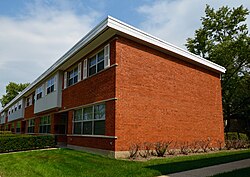
Boone County is a county located in the U.S. state of Illinois. As of the 2010 census, the population was 54,165. Its county seat is Belvidere.

Radburn is an unincorporated community located within Fair Lawn in Bergen County, New Jersey, United States.

In architecture and city planning, a terrace or terraced house (UK) or townhouse (US) is a form of medium-density housing that originated in Europe in the 16th century, whereby a row of attached dwellings share side walls. They are also known in some areas as row houses or row homes.
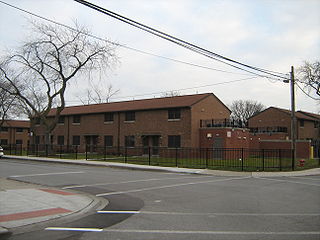
Riverdale is one of the 77 official community areas of Chicago, Illinois and is located on the city's far south side.

Wave Hill is a 28-acre (11 ha) estate in the Hudson Hill section of Riverdale in the Bronx, New York City. Wave Hill currently consists of public horticultural gardens and a cultural center, all situated on the slopes overlooking the Hudson River, with expansive views across the river to the New Jersey Palisades. The estate includes two houses and a botanical garden. The oldest part of the main house, Wave Hill House, dates back to 1843; Glyndor House dates from 1927 and contains a multi-room art gallery. Perkins Visitor Center, which was originally a garage, contains a gift shop and an information desk.

Lincoln Home National Historic Site preserves the Springfield, Illinois home and a historic district where Abraham Lincoln lived from 1844 to 1861, before becoming the 16th President of the United States. The presidential memorial includes the four blocks surrounding the home and a visitor center.

Fairlington is an unincorporated neighborhood in Arlington County, Virginia, United States, located adjacent to Shirlington in the southernmost part of the county on the boundary with the City of Alexandria. The main thoroughfares are Interstate 395 which divides the neighborhood into North and South Fairlington, State Route 7 and State Route 402.

The Illinois Governor's Mansion is the official residence of the Governor of Illinois. It is located at 410 E. Jackson Street in the state capital, Springfield, Illinois. The Italianate-style Mansion was designed by Chicago architect John M. Van Osdel with a modified 'H' shaped configuration with a long central section, and the front and back on the sides of the 'H'. The 16-room manor was completed in 1855 and was first occupied by governor Joel Matteson, who held the official grand opening on January 10, 1856. It is one of the oldest historic residences in the state of Illinois and one of the three oldest continuously occupied governor's mansions in the United States. In 1898 alterations to the exterior added neoclassical elements. In 1972, the Illinois Governor's Mansion Association was founded as a charitable corporation to assist in the maintenance and programming at the mansion. The Mansion was added to the National Register of Historic Places in 1976.

Lafayette Park is a historic urban renewal district east of Downtown Detroit and contains the largest collection of residential buildings designed by Ludwig Mies van der Rohe. The northern section planned and partially built by Mies is listed in the National Register of Historic Places. In 2015 it was designated a National Historic Landmark District. Lafayette Park is located on the city's lower east side directly south of the Eastern Market Historic District. In general, the neighborhood, including portions developed by other architects, has been regarded as an incubator of progressive architecture and one of the few historically stable urban renewal zones in the United States.

The David Davis Mansion, also known as Clover Lawn, is a Victorian home in Bloomington, Illinois that was the residence of David Davis, Supreme Court justice (1862–1877) and Senator from Illinois. The mansion has been a state museum since 1960. It was added to the National Register of Historic Places in 1972 and was designated a National Historic Landmark in 1975.. In celebration of the 2018 Illinois Bicentennial, David Davis Mansion was selected as one of the Illinois 200 Great Places by the American Institute of Architects Illinois component.

Pullman National Monument, also known as The Pullman District and Pullman Historic District, is located in Chicago and was the first model, planned industrial community in the United States. The district had its origins in the manufacturing plans and organization of the Pullman Company, and became one of the most famous company towns in the United States, as well as the scene of the violent 1894 Pullman strike. It was built for George Pullman as a place to produce the famous Pullman sleeping cars.

Chatham Village is a community within the larger Mount Washington neighborhood of the City of Pittsburgh, Pennsylvania, and an internationally acclaimed model of community design. It is roughly bounded by Virginia Ave., Bigham St., Woodruff St., Saw Mill Run Blvd., and Olympia Rd. It was declared a National Historic Landmark in 2005 as a remarkably well-preserved example of Garden City Movement design. The village is owned and operated as a cooperative by its residents.
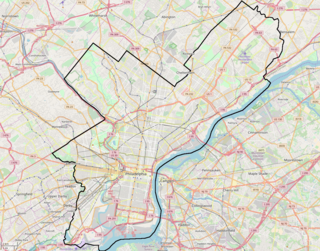
Poplar is a neighborhood in Lower North Philadelphia. It is located north of Callowhill, between Spring Garden/Fairmount and Northern Liberties, bounded roughly by Girard Avenue to the north, North Broad Street to the west, Spring Garden Street to the south, and 5th Street to the east. The neighborhood is mostly residential with commercial frontage on Broad Street and Girard Avenue and some industrial facilities to the west of the railroad tracks along Percy St. and 9th St.

Hilltop Manor is an historic apartment complex located in Bladensburg, Prince George's County, Maryland. The complex consists of eight brick garden apartment buildings, each of which is divided into two to six units or sections, constructed in 1942 and 1943.
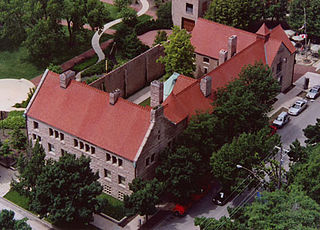
Prairie Avenue is a north–south street on the South Side of Chicago, which historically extended from 16th Street in the Near South Side to the city's southern limits and beyond. The street has a rich history from its origins as a major trail for horseback riders and carriages. During the last three decades of the 19th century, a six-block section of the street served as the residence of many of Chicago's elite families and an additional four-block section was also known for grand homes. The upper six-block section includes part of the historic Prairie Avenue District, which was declared a Chicago Landmark and added to the National Register of Historic Places.

The Garden Homes Historic District is a residential historic district located in the Chatham neighborhood of the South Side, Chicago, Illinois. The district includes 152 residential buildings, 88 of which are contributing buildings, built in 1919-20 as Chicago's first large housing project. The newly formed Chicago Housing Association, a group of 22 prominent Chicago businessmen that included J. Ogden Armour, Charles H. Wacker, and William Wrigley, Jr., planned the homes as an affordable housing project for working-class Chicagoans. At the time, the city was suffering from a post-World War I housing crisis, and many of its working-class residents lived in tenements or other unlivable housing. Architect Charles Sumner Frost designed the homes, which were mainly brick cottages and stucco duplexes. The houses were built on unusually large lots for the time; the extra land was designed to serve as garden space for residents.
Koning Eizenberg Architecture (KEA) is an architecture firm located in Santa Monica, California established in 1981. Working collaboratively, principals Hank Koning, Julie Eizenberg, Brian Lane, and Nathan Bishop think with developers, cities and not-for-profit clients to reveal new possibilities for the design of housing and neighborhood places that strengthen community. Their groundbreaking work has been published extensively both in the US and abroad, and has earned over 125 awards for design, sustainability and historic preservation.

The Promontory Apartments is a 22-story skyscraper in Hyde Park, Chicago, Illinois, United States designed by Ludwig Mies van der Rohe. It was the first skyscraper Mies designed and was the first of his buildings to feature concepts such as an exposed skeleton. The cooperative building overlooking Burnham Park has 122 units.
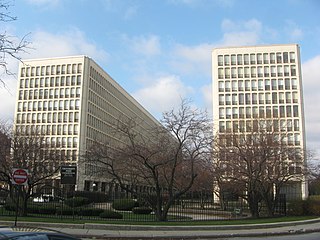
The University Apartments, also known as the University Park Condominiums, are a pair of ten-story towers in Chicago, Illinois designed by I. M. Pei and Araldo Cossutta. The project was part of a city initiative to revitalize residential development in Hyde Park just north of the University of Chicago. Within the Hyde Park neighborhood, they are colloquially known as "Monoxide Island."

The American Woolen Company Townhouses are a collection of brick townhouses built c. 1907 by the American Woolen Company in Lawrence, Massachusetts. They were part of a program of company-built housing between 1906 and 1910 that included the nearby American Woolen Mill Housing District. The townhouses are located on a series of short streets off Market Street in South Lawrence. A historic district comprising these six buildings was listed on the National Register of Historic Places in 2012.
